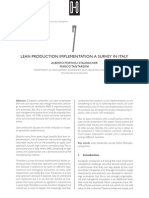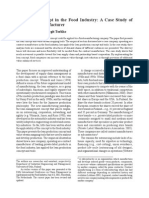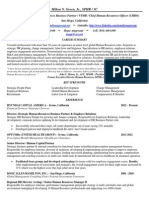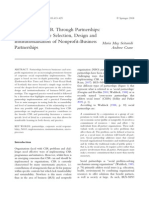Lean Thinking and Supply Chain Management: Thomas J. Goldsby and Sebastián J. García-Dastugue
Lean Thinking and Supply Chain Management: Thomas J. Goldsby and Sebastián J. García-Dastugue
Uploaded by
cp3y2000-scribdCopyright:
Available Formats
Lean Thinking and Supply Chain Management: Thomas J. Goldsby and Sebastián J. García-Dastugue
Lean Thinking and Supply Chain Management: Thomas J. Goldsby and Sebastián J. García-Dastugue
Uploaded by
cp3y2000-scribdOriginal Description:
Original Title
Copyright
Available Formats
Share this document
Did you find this document useful?
Is this content inappropriate?
Copyright:
Available Formats
Lean Thinking and Supply Chain Management: Thomas J. Goldsby and Sebastián J. García-Dastugue
Lean Thinking and Supply Chain Management: Thomas J. Goldsby and Sebastián J. García-Dastugue
Uploaded by
cp3y2000-scribdCopyright:
Available Formats
CHAPTER
Lean Thinking and
12 Supply Chain Management
Thomas J. Goldsby and Sebastián J. García-Dastugue
Overview
Lean thinking provides principles and tools used to eliminate waste and to
strive for perfection through continuous improvement. Though lean thinking was
conceptualized to apply to all activities within the firm and across companies in
the supply chain, usually lean is employed in operational settings within a single
Lean thinking in firm. Lean thinking in supply chain management is the use of lean principles to
supply chain align activities across corporate functions within the firm and to manage business
management is the relationships with customers and suppliers. We show how lean principles and
use of lean principles tools can be used in the context of the supply chain management framework. Also,
to align activities we describe forms of waste that result from the lack of alignment in the supply
across corporate chain – wastes that need to be eliminated in order to create greatest value for the
functions within the end-customer.
firm and to manage
business relationships
Introduction
with customers and
suppliers. The term “lean” first appeared in The Machine that Changed the World1 in
reference to Toyota and its much heralded Toyota Production System (TPS). The
book detailed the considerable differences observed between Toyota and its
automotive rivals in an industry-wide study, where Toyota managed to achieve
higher quality and greater output with less material, less space, and less equipment
in less time– and was, hence, “leaner” than the competition. The study also
documented the company’s discipline and relentless pursuit of perfection through
continuous improvement, or kaizen. Out of the original research conducted by
Womack and Jones and others, a movement was born.
Since the mid-1990s, lean manufacturing has gained much attention in trade
publications, industry reports, and case studies, where companies cite the benefits
achieved through lean implementations. While reported benefits vary, a sample
shows that lean principles successfully deployed in manufacturing can result in a
90% reduction in lead time, doubling of productivity, 75% reduction in inventory,
1
Womack, James P., Daniel T. Jones, and Daniel Roos, The Machine that Changed the World: The Story
of Lean Production, New York: Harper Perennial, 1991.
SUPPLY CHAIN MANAGEMENT 217
You might also like
- Seminar Report On Lean ManufacturingDocument26 pagesSeminar Report On Lean ManufacturingAbhishek BhardwajNo ratings yet
- BUS300 1.1 Understanding Operations ManagementDocument6 pagesBUS300 1.1 Understanding Operations ManagementMitochiNo ratings yet
- Discussion Questions Solution Supply Chain ManagementDocument4 pagesDiscussion Questions Solution Supply Chain Managementprince185100% (3)
- Modernityscotland 20 Mark Electoral Data Question Higher Politics Marking InstructionsDocument2 pagesModernityscotland 20 Mark Electoral Data Question Higher Politics Marking InstructionsJohn McTaggartNo ratings yet
- Track Earned ValueDocument20 pagesTrack Earned Valueyoursasim100% (1)
- Notes Unit 1Document16 pagesNotes Unit 1Dandally RoopaNo ratings yet
- Week 5 - Topic OverviewDocument15 pagesWeek 5 - Topic OverviewmichNo ratings yet
- Partnering Lean Production and The High PerformancDocument8 pagesPartnering Lean Production and The High PerformancGayathri arulNo ratings yet
- Understanding Operations ManagementDocument7 pagesUnderstanding Operations ManagementDianna DayawonNo ratings yet
- Chapter One Operation Management Designs, Operates, and Improves Productive Systems-Systems ForDocument12 pagesChapter One Operation Management Designs, Operates, and Improves Productive Systems-Systems ForwubeNo ratings yet
- Art 7Document9 pagesArt 7José Pérez PérezNo ratings yet
- Modeling Lean, Agile, and Leagile Supply Chain StrategiesDocument24 pagesModeling Lean, Agile, and Leagile Supply Chain Strategiesramirali100% (1)
- Understanding Project ManagementDocument16 pagesUnderstanding Project ManagementlalitNo ratings yet
- Lean Automated Manufacturing: Avoiding The Pitfalls To Embrace The OpportunitiesDocument7 pagesLean Automated Manufacturing: Avoiding The Pitfalls To Embrace The OpportunitiesSharath ChandraNo ratings yet
- Fashionsta and WanistaDocument14 pagesFashionsta and WanistaZeyshan TariqNo ratings yet
- LSSGB BOK SecondEdition2014 Chap11-19Document26 pagesLSSGB BOK SecondEdition2014 Chap11-19brianmiller0074No ratings yet
- A Comprehensive Study On Implementation of Lean Manufacturing in Coir Based SME's in KeralaDocument5 pagesA Comprehensive Study On Implementation of Lean Manufacturing in Coir Based SME's in KeralaPrasanth MenonNo ratings yet
- Background of Lean Thinking Lean Thinking: The Machine That Changed The WorldDocument1 pageBackground of Lean Thinking Lean Thinking: The Machine That Changed The WorldAnonymous NEsrMl9QNo ratings yet
- The Lean Concept in The Food IndustryDocument11 pagesThe Lean Concept in The Food Industryfelipe_aaNo ratings yet
- Unit 3Document35 pagesUnit 3ShrutiNo ratings yet
- Lean Production Literature ReviewDocument8 pagesLean Production Literature Reviewafdtwtdsa100% (1)
- Seminar Report On Lean ManufacturingDocument26 pagesSeminar Report On Lean ManufacturingShivraj Allagi67% (3)
- Relationship Management-Knowledge How ToDocument20 pagesRelationship Management-Knowledge How ToRoshanNo ratings yet
- Quality ManagementDocument6 pagesQuality ManagementNickesh ShahNo ratings yet
- c1Document16 pagesc1FaizanNo ratings yet
- Improvement of Manufacturing ProcessesDocument9 pagesImprovement of Manufacturing ProcessesNavnath TamhaneNo ratings yet
- Leagile - Ran TQM - 26 - 03 - 20 RevisionDocument21 pagesLeagile - Ran TQM - 26 - 03 - 20 RevisionaghowelNo ratings yet
- A12. Lean and Six Sigma. Philosophies and ToolsDocument71 pagesA12. Lean and Six Sigma. Philosophies and ToolsPiotrNo ratings yet
- Lean Production - ReportDocument29 pagesLean Production - ReportAlexanderNo ratings yet
- Cbac Midterm 2Document4 pagesCbac Midterm 2JecaNo ratings yet
- Manufacturing Strategy Linked To Product Life Cycle: Ruth - Saven@ipe - Liu.seDocument29 pagesManufacturing Strategy Linked To Product Life Cycle: Ruth - Saven@ipe - Liu.seTika CahyaNo ratings yet
- Lean para ViviosDocument3 pagesLean para ViviosPérez AlejandroNo ratings yet
- Lean Manufacturing in Small and Medium Enterprises - 3Document20 pagesLean Manufacturing in Small and Medium Enterprises - 3Miguel MárquezNo ratings yet
- Lean in FMCGDocument25 pagesLean in FMCGMinarva Mallik100% (1)
- Comparing Lean and Agile Logistics Strategies: A Case StudyDocument21 pagesComparing Lean and Agile Logistics Strategies: A Case StudyNico インNo ratings yet
- EIS W6-W7 Operation ManagementDocument15 pagesEIS W6-W7 Operation ManagementEngku KhairiNo ratings yet
- SIP Project of VSMDocument77 pagesSIP Project of VSMPrasad BachhavNo ratings yet
- Principles of Lean Thinking Rev D 2004Document39 pagesPrinciples of Lean Thinking Rev D 2004sprathNo ratings yet
- Emerging Concepts of Lean Supply Management - Study PurposeDocument10 pagesEmerging Concepts of Lean Supply Management - Study PurposeLiew Ee HoongNo ratings yet
- Learning From MistakesDocument7 pagesLearning From MistakesRamón G. PachecoNo ratings yet
- Implementing Lean Sigma in Pharmaceutical Research and DevelopmentDocument13 pagesImplementing Lean Sigma in Pharmaceutical Research and DevelopmentAyodeji Olanrewaju100% (1)
- Chapter One 1.1 BackgroundDocument46 pagesChapter One 1.1 BackgroundAg0% (2)
- 07 A Literature Review of Lean ManufacturingDocument10 pages07 A Literature Review of Lean ManufacturingVanessa SantosNo ratings yet
- Ram ReportDocument84 pagesRam ReportRaman LuxNo ratings yet
- Disruptive Innovation in Health Care DeliveryDocument7 pagesDisruptive Innovation in Health Care DeliveryGopinath KrishnanNo ratings yet
- Grop 7 - Lean Articles ReviewDocument9 pagesGrop 7 - Lean Articles Reviewprakhar guptaNo ratings yet
- Competitive Advantage Through OperationsDocument2 pagesCompetitive Advantage Through OperationsnirmalamanjunathNo ratings yet
- Status of Implementation of Lean Manufacturing Principles in The Context of Indian Industry: A Literature ReviewDocument6 pagesStatus of Implementation of Lean Manufacturing Principles in The Context of Indian Industry: A Literature ReviewAeyrul KhairulNo ratings yet
- Lean Enterprise FundamentalsDocument35 pagesLean Enterprise FundamentalsGift ChaliNo ratings yet
- Lean Manufacturing: Theory and Practice: Ramunė Čiarnienė, Milita VienažindienėDocument7 pagesLean Manufacturing: Theory and Practice: Ramunė Čiarnienė, Milita VienažindienėVanessa SantosNo ratings yet
- Production Oper Manag - 2016 - Lee - Using Value Chains To Enhance InnovationDocument16 pagesProduction Oper Manag - 2016 - Lee - Using Value Chains To Enhance Innovationmax wenNo ratings yet
- Lean Operations PDFDocument5 pagesLean Operations PDFRamón G. PachecoNo ratings yet
- Interacrive Learning MGT311Document10 pagesInteracrive Learning MGT311raghadzah.7No ratings yet
- Applying Lean in Textile IndustryDocument12 pagesApplying Lean in Textile IndustryPaul AndelaNo ratings yet
- Content ServerDocument8 pagesContent ServerSHASHANK ROHITNo ratings yet
- A Review On Lean ManufacturingDocument10 pagesA Review On Lean ManufacturingAdvanced Research Publications100% (1)
- Manufacturing Process AssignmentDocument5 pagesManufacturing Process AssignmentPalani SuntharajanNo ratings yet
- Summary of Clayton M. Christensen, Jerome H. Grossman & Jason Hwang's The Innovator's PrescriptionFrom EverandSummary of Clayton M. Christensen, Jerome H. Grossman & Jason Hwang's The Innovator's PrescriptionNo ratings yet
- World Class Manufacturing: The Next Decade: Building Power, Strength, and ValueFrom EverandWorld Class Manufacturing: The Next Decade: Building Power, Strength, and ValueRating: 3 out of 5 stars3/5 (2)
- 2016finms214 Subscription Business Model PensionDocument8 pages2016finms214 Subscription Business Model Pensioncp3y2000-scribdNo ratings yet
- AI Assisted Knowledge Assessment Techniques 2022 Computers and Education ADocument12 pagesAI Assisted Knowledge Assessment Techniques 2022 Computers and Education Acp3y2000-scribdNo ratings yet
- Service Driven Business Model InnovationDocument38 pagesService Driven Business Model Innovationcp3y2000-scribdNo ratings yet
- How Students Self Assessment Behavior Affec 2022 Computers and Education ADocument8 pagesHow Students Self Assessment Behavior Affec 2022 Computers and Education Acp3y2000-scribdNo ratings yet
- Rethinking The Entwinement Between Artificial Intell 2022 Computers and EducDocument16 pagesRethinking The Entwinement Between Artificial Intell 2022 Computers and Educcp3y2000-scribdNo ratings yet
- Artificial Intelligence in Early Childhood 2022 Computers and Education ArtDocument13 pagesArtificial Intelligence in Early Childhood 2022 Computers and Education Artcp3y2000-scribdNo ratings yet
- Cost - C/S System CostsDocument8 pagesCost - C/S System Costscp3y2000-scribdNo ratings yet
- Requisit 2Document6 pagesRequisit 2cp3y2000-scribdNo ratings yet
- Sysmod - System Models: Population Service Rate Queue SizeDocument11 pagesSysmod - System Models: Population Service Rate Queue Sizecp3y2000-scribdNo ratings yet
- Think About A MannerDocument6 pagesThink About A Mannercp3y2000-scribdNo ratings yet
- Servtime - Computation of Service TimesDocument11 pagesServtime - Computation of Service Timescp3y2000-scribdNo ratings yet
- Characteristics of MicroprocessorsDocument12 pagesCharacteristics of Microprocessorscp3y2000-scribdNo ratings yet
- Webmodels - Performance Models of Web SystemsDocument5 pagesWebmodels - Performance Models of Web Systemscp3y2000-scribdNo ratings yet
- ResourcDocument1 pageResourccp3y2000-scribdNo ratings yet
- Think About A MannerDocument6 pagesThink About A Mannercp3y2000-scribdNo ratings yet
- In This Moment The Mais Thing To Know IsDocument1 pageIn This Moment The Mais Thing To Know Iscp3y2000-scribdNo ratings yet
- There Is W To Mention A ScaleDocument8 pagesThere Is W To Mention A Scalecp3y2000-scribdNo ratings yet
- Think About A MannerDocument6 pagesThink About A Mannercp3y2000-scribdNo ratings yet
- In This Moment The Mais Thing To Know IsDocument1 pageIn This Moment The Mais Thing To Know Iscp3y2000-scribdNo ratings yet
- HR Director VPHR CHRO Employee Relations in San Diego CA Resume Milton GreenDocument2 pagesHR Director VPHR CHRO Employee Relations in San Diego CA Resume Milton GreenMiltonGreenNo ratings yet
- Cost Management PlanDocument7 pagesCost Management PlanTƛyyƛb ƛliNo ratings yet
- SCM Infrastructure PradeepDocument33 pagesSCM Infrastructure PradeepPradeep Kumar MNo ratings yet
- DmadvDocument4 pagesDmadvmonigpNo ratings yet
- Corporate Governance in VietnamDocument69 pagesCorporate Governance in Vietnamhi_monestyNo ratings yet
- Toyota Production SystemDocument3 pagesToyota Production SystemmehtazeelNo ratings yet
- Strategic Leadership For Better Public Sector Performance: By: Adi Budiarso (University of Canberra)Document20 pagesStrategic Leadership For Better Public Sector Performance: By: Adi Budiarso (University of Canberra)Muthmainnah 1No ratings yet
- Cofs Customer Service and Supply Chain Diagnostic 4972Document11 pagesCofs Customer Service and Supply Chain Diagnostic 4972Pallav ChatterjeeNo ratings yet
- Pad305 Elements of Government Summary 08024665051Document43 pagesPad305 Elements of Government Summary 08024665051emmanuel okorieNo ratings yet
- Real SAA-C02 Exam Questions 2021Document11 pagesReal SAA-C02 Exam Questions 2021SAA-C02 DumpsIT.comNo ratings yet
- Implementing CSR Through Partnerships: Understanding The Selection, Design and Institutionalisation of Nonprofit-Business PartnershipsDocument17 pagesImplementing CSR Through Partnerships: Understanding The Selection, Design and Institutionalisation of Nonprofit-Business PartnershipsChris JarvisNo ratings yet
- PRESENTATION ON SJIBL For IUBATDocument19 pagesPRESENTATION ON SJIBL For IUBATShahadatHossainShakilNo ratings yet
- Itil 2011mind MapsDocument1 pageItil 2011mind MapsGabriel CamachoNo ratings yet
- Anuradha Joshi CVDocument2 pagesAnuradha Joshi CVriyaNo ratings yet
- 0021 Voters - List. Bay, Laguna - Brgy Bitin - Precint.0140aDocument5 pages0021 Voters - List. Bay, Laguna - Brgy Bitin - Precint.0140aIwai MotoNo ratings yet
- Performance Management PlanDocument9 pagesPerformance Management Planمحمد خطابNo ratings yet
- Means of Achieving Strategies 6Document6 pagesMeans of Achieving Strategies 6Jobby Jaranilla50% (2)
- Election ProtestDocument9 pagesElection ProtestKATHRINE TUNGPALANNo ratings yet
- W8 Kja XMO63Document2 pagesW8 Kja XMO63s25475628No ratings yet
- Secure Online Election (E-Voting) System Using Fingerprint AuthenticationDocument8 pagesSecure Online Election (E-Voting) System Using Fingerprint AuthenticationxixaNo ratings yet
- Citizen Engagement in Pakistan Final For Publishing Rev KII RedactedDocument81 pagesCitizen Engagement in Pakistan Final For Publishing Rev KII RedactedJunaid AkbarNo ratings yet
- Ethics 10 - Brijendra SinghDocument5 pagesEthics 10 - Brijendra Singh12622No ratings yet
- Senior Buyer Planner in Houston TX Resume Robert GreenDocument2 pagesSenior Buyer Planner in Houston TX Resume Robert GreenRobertGreenNo ratings yet
- European Business School Rankings 2011Document1 pageEuropean Business School Rankings 2011Juan JaraNo ratings yet
- Reducing Delays in Delivering Garments Using DMAIC-Six Sigma MethodologyDocument16 pagesReducing Delays in Delivering Garments Using DMAIC-Six Sigma MethodologyPravin ShindeNo ratings yet
- Gap Analysis ISO 9001-2015Document17 pagesGap Analysis ISO 9001-2015Yudi ArkanantaNo ratings yet
- IT Deployment RisksDocument36 pagesIT Deployment RisksPaul Matthew Parcon100% (1)












































































































